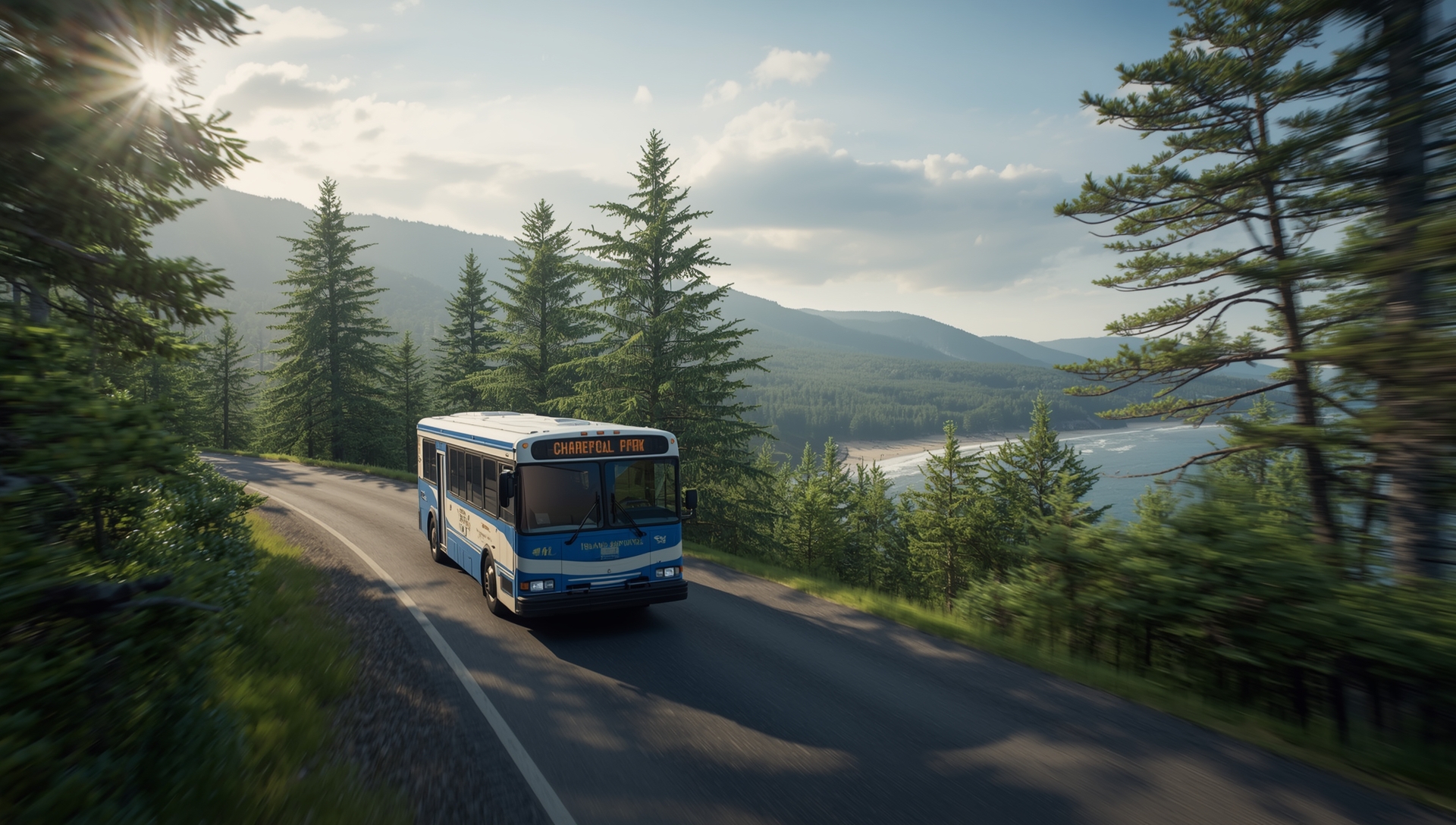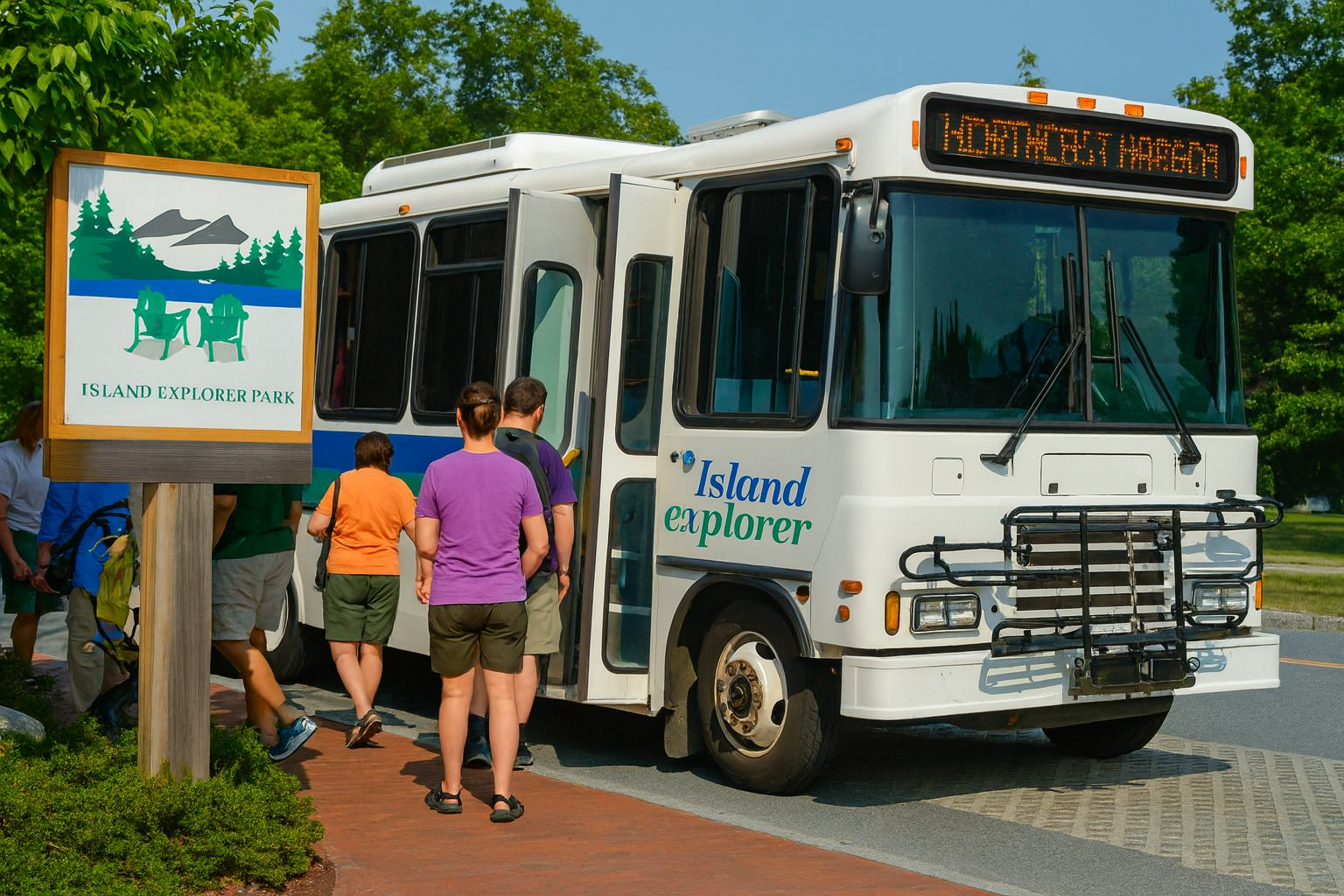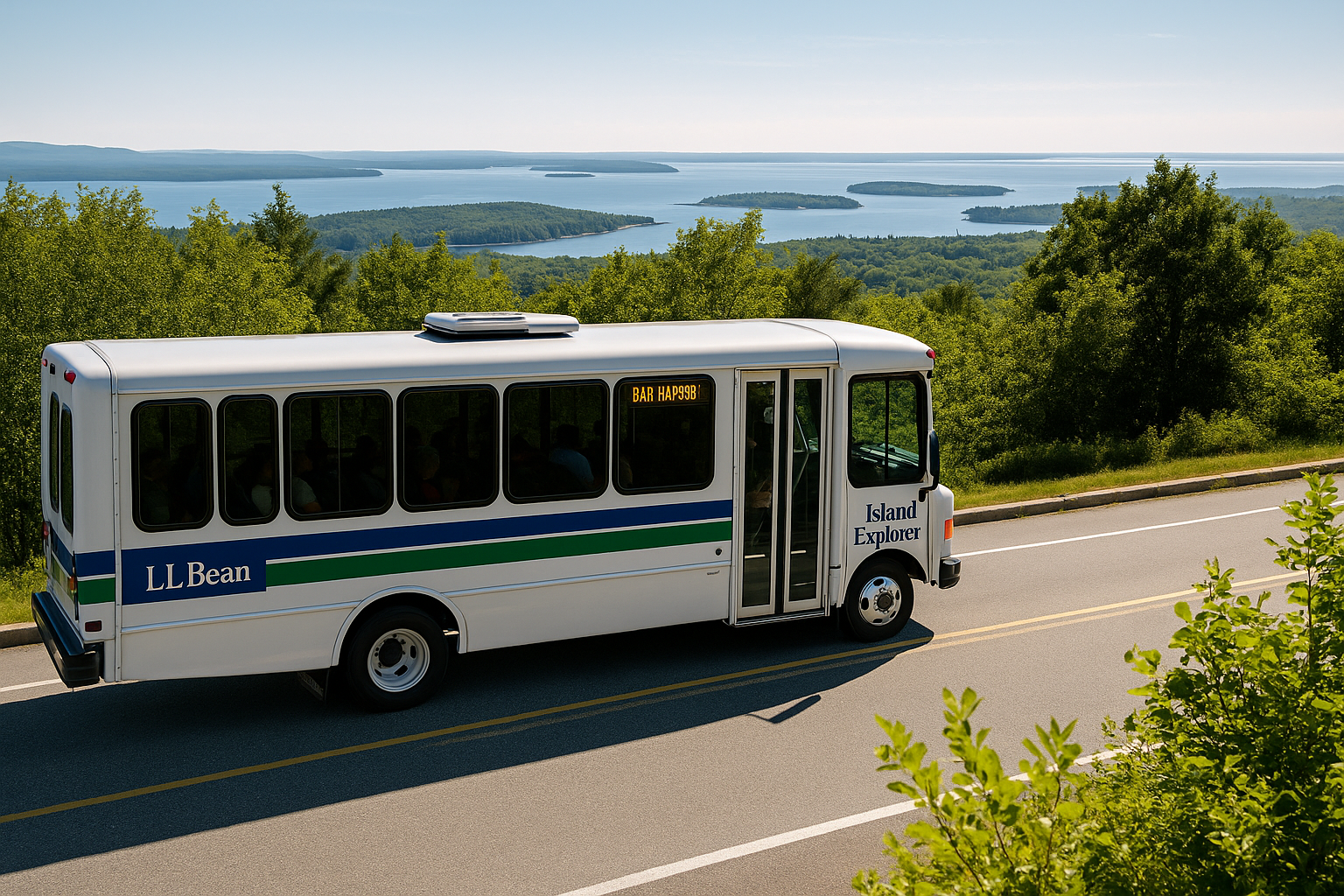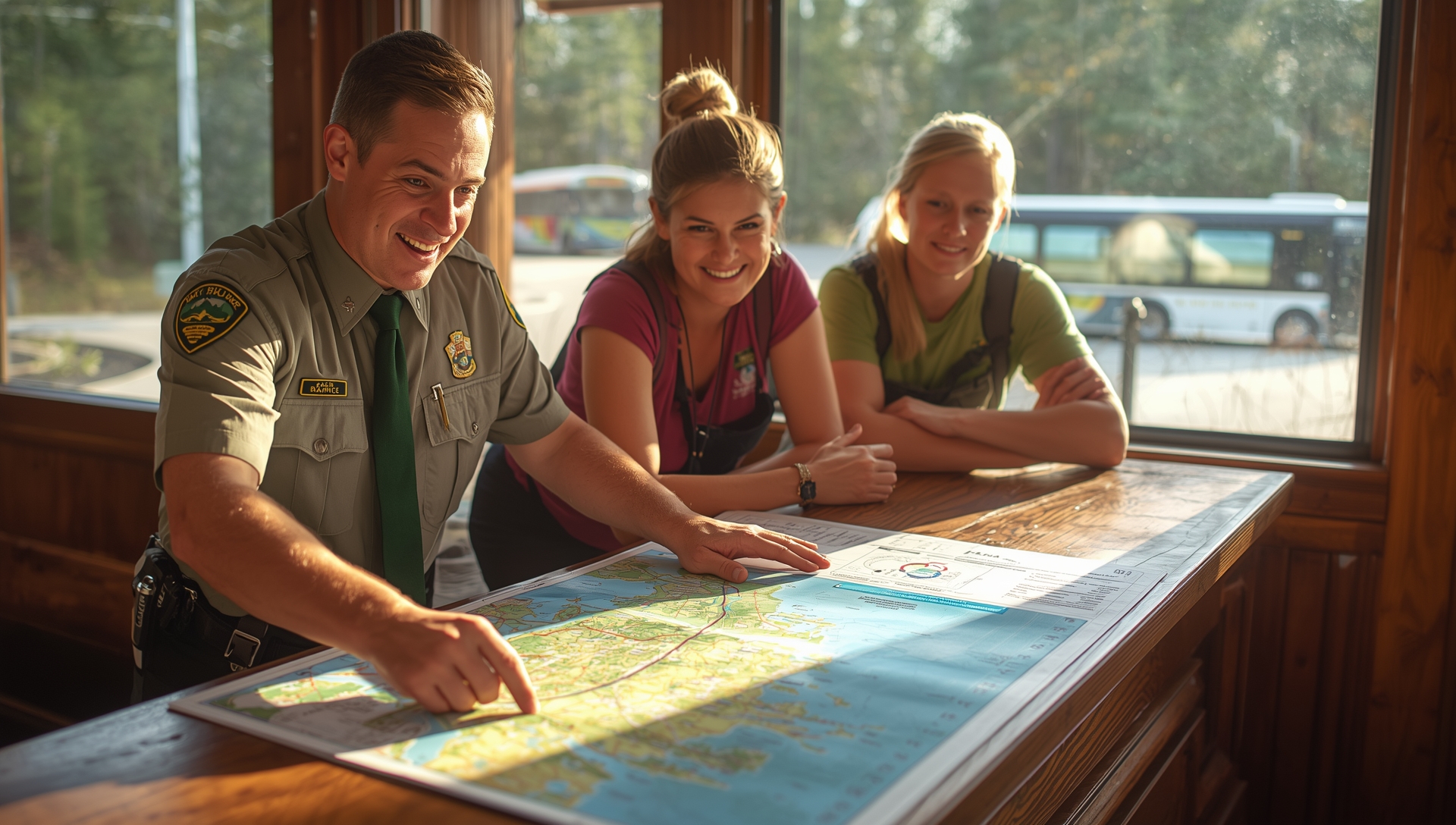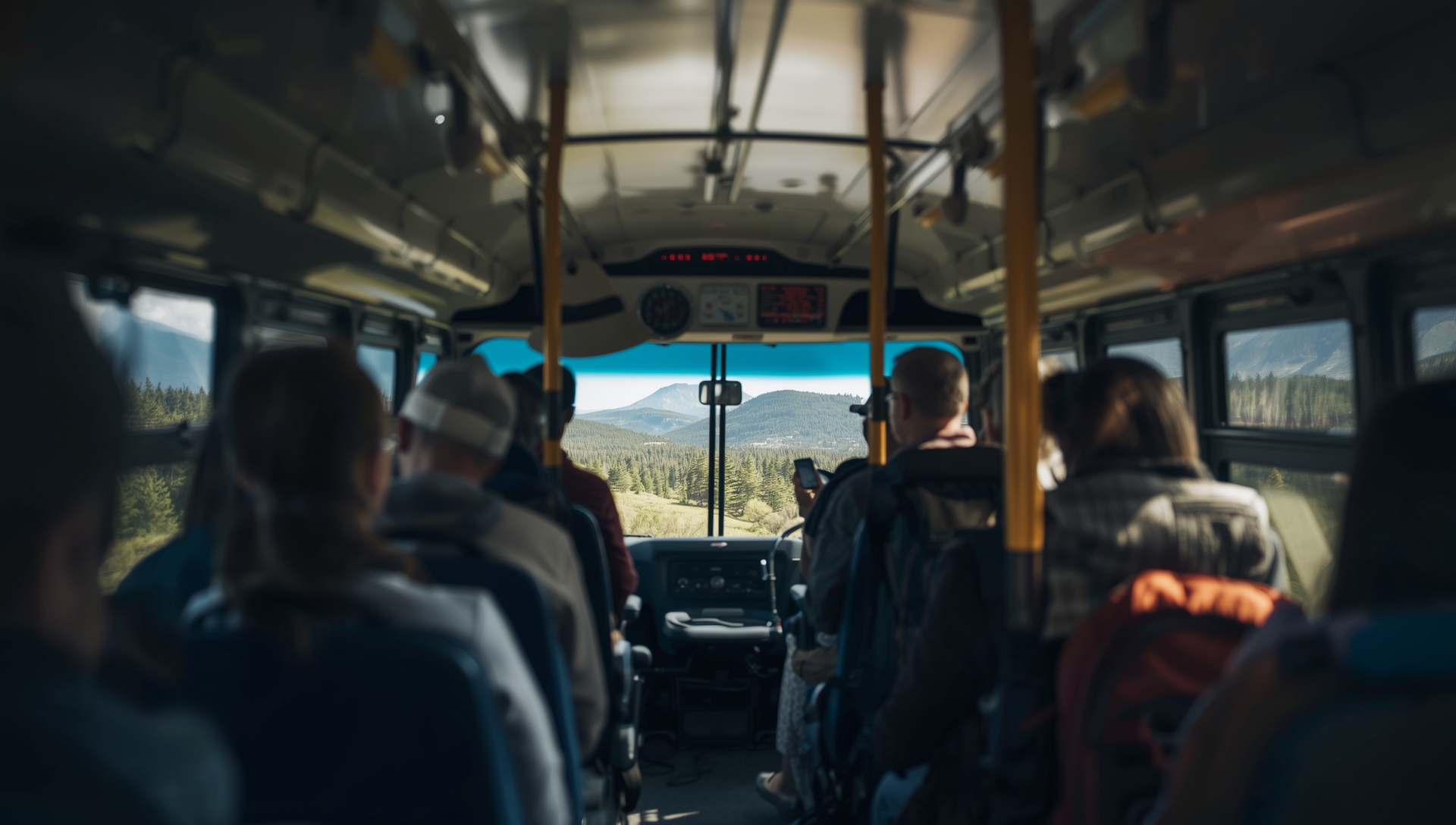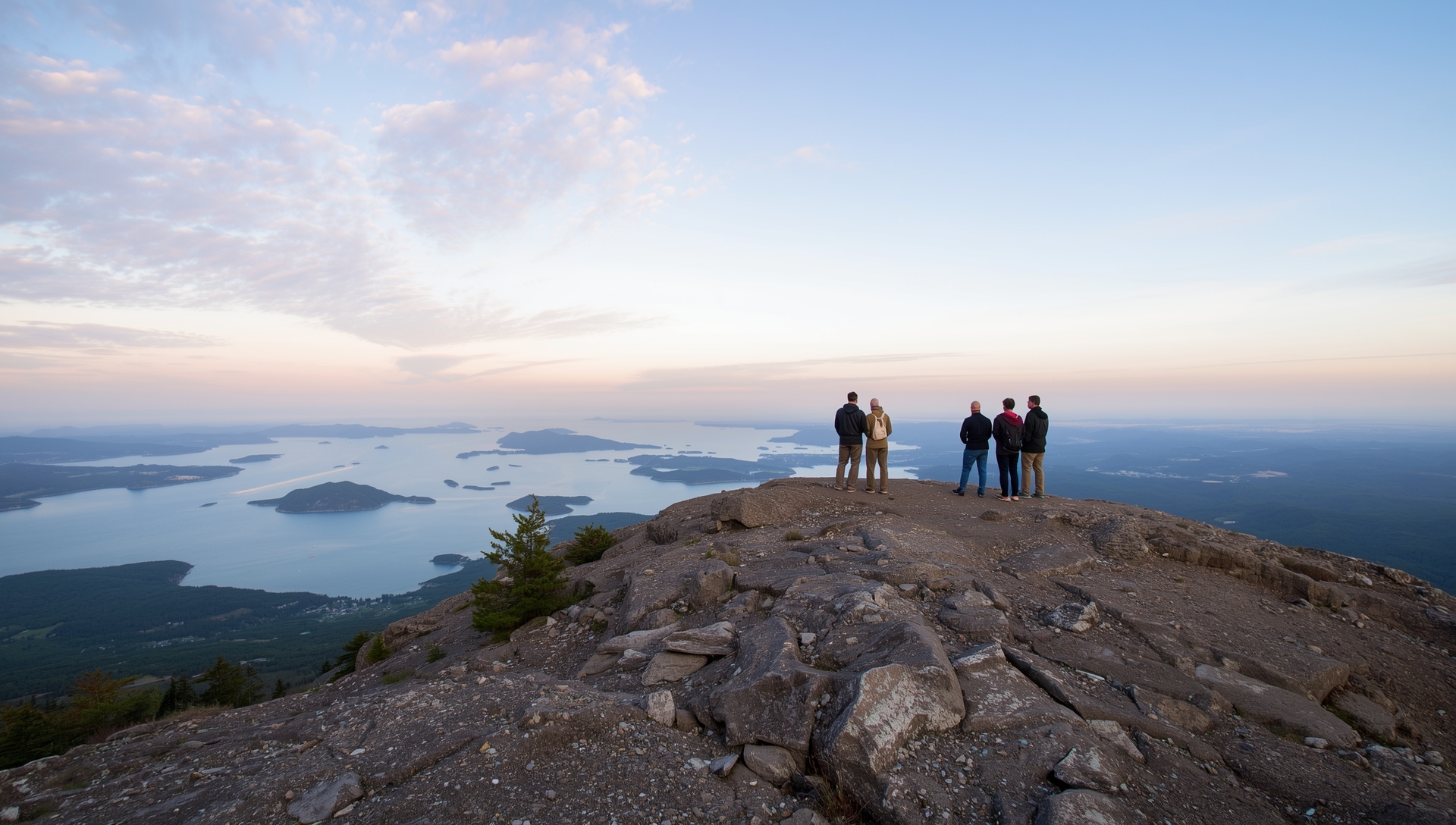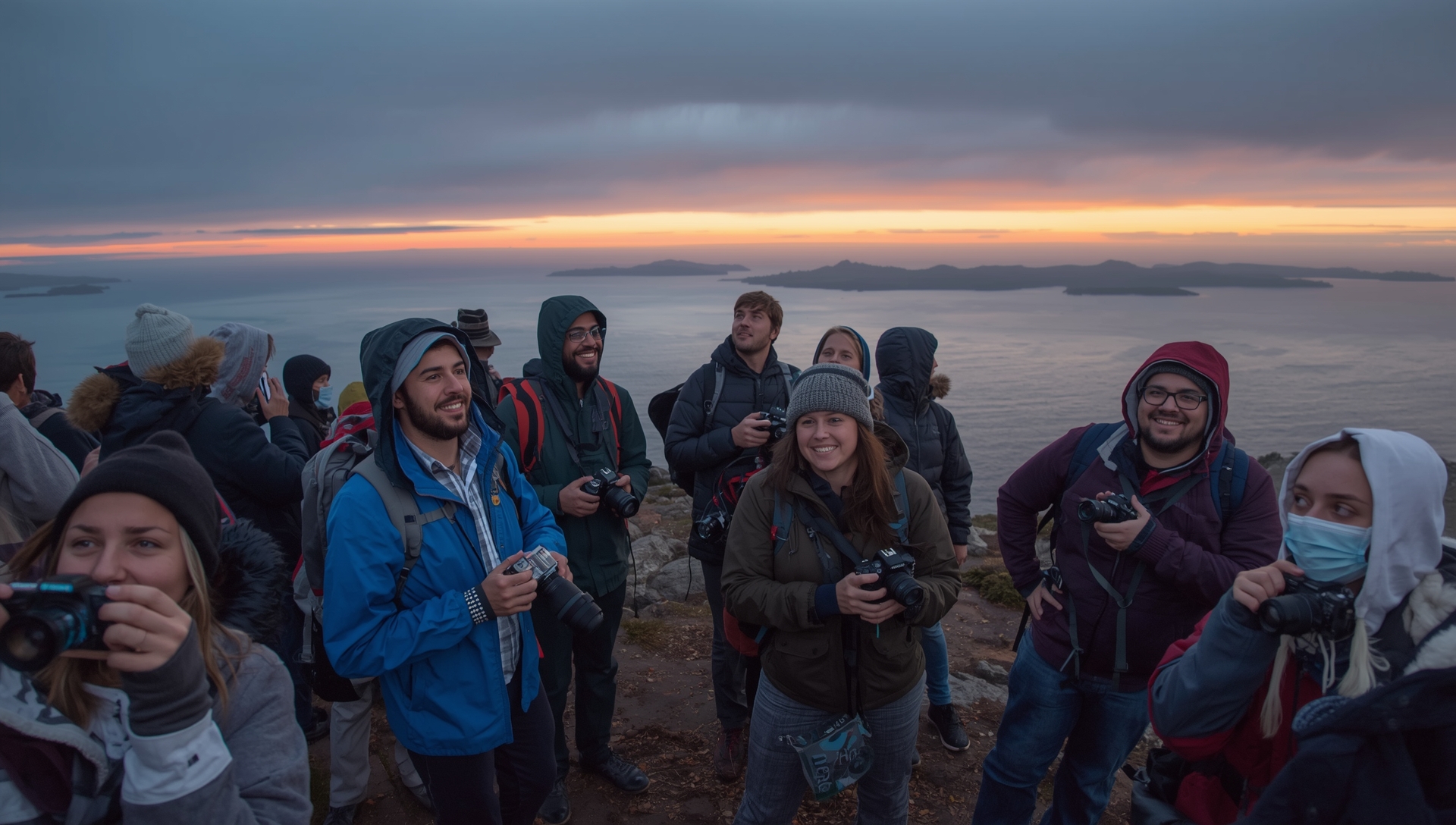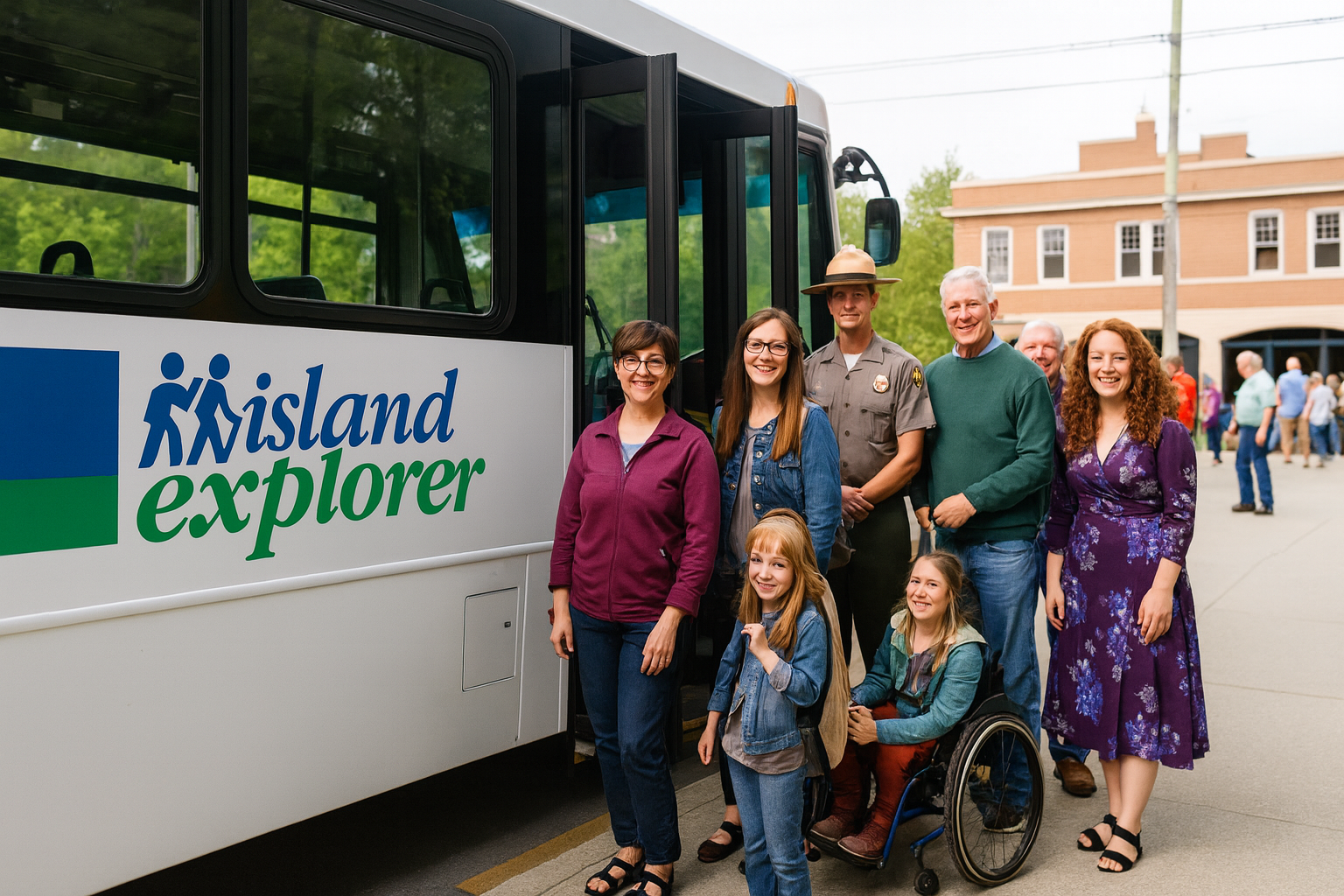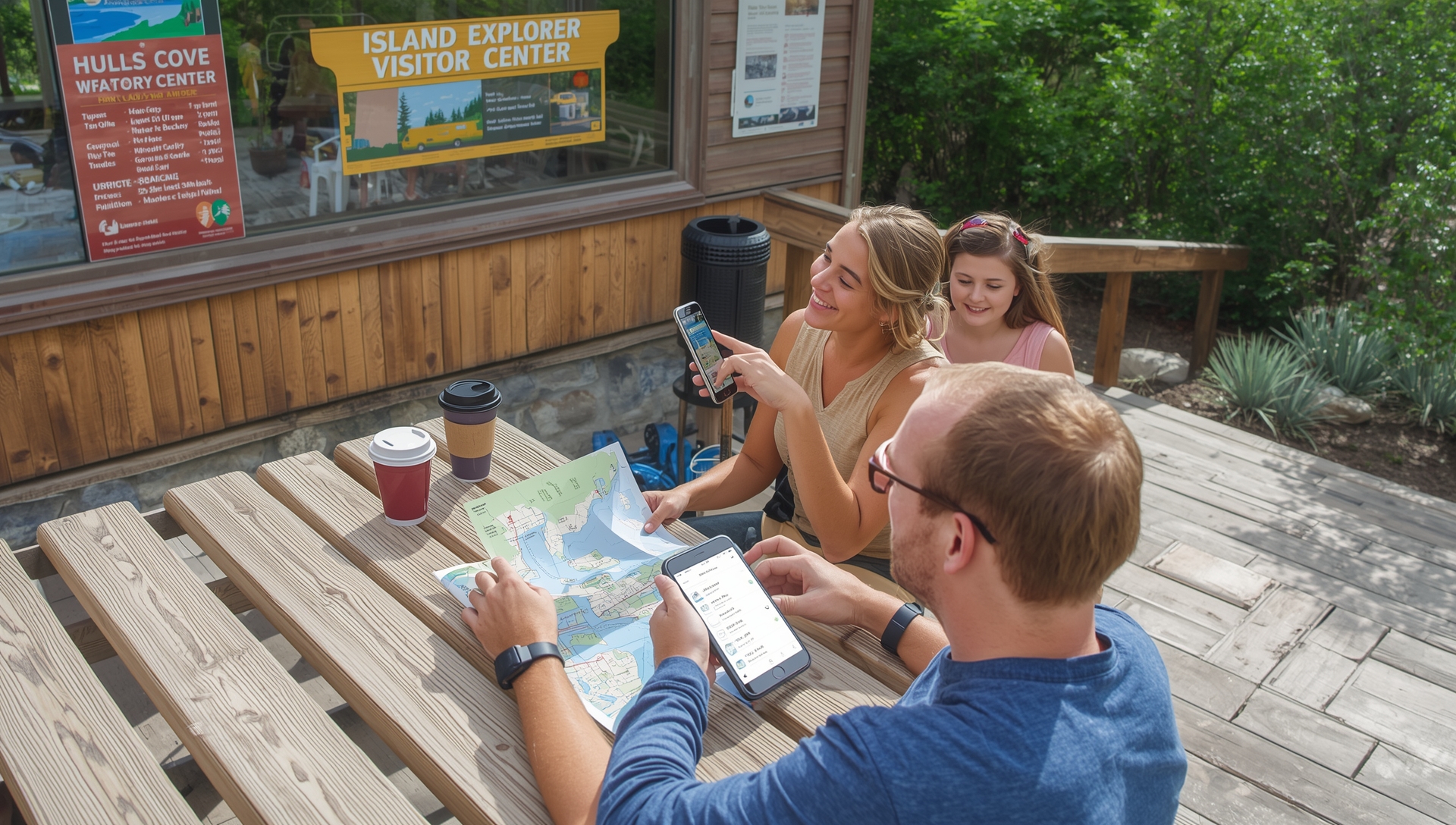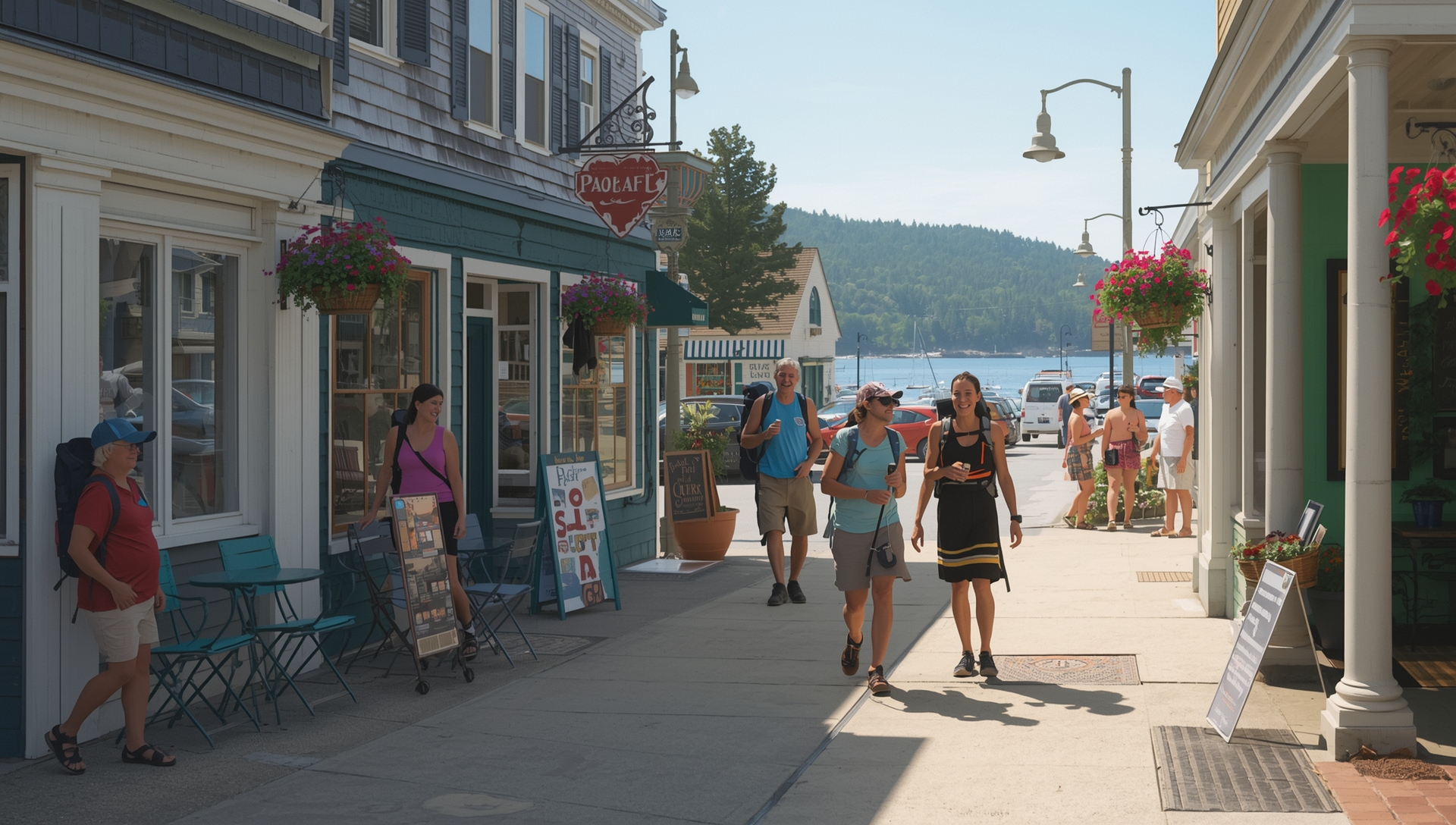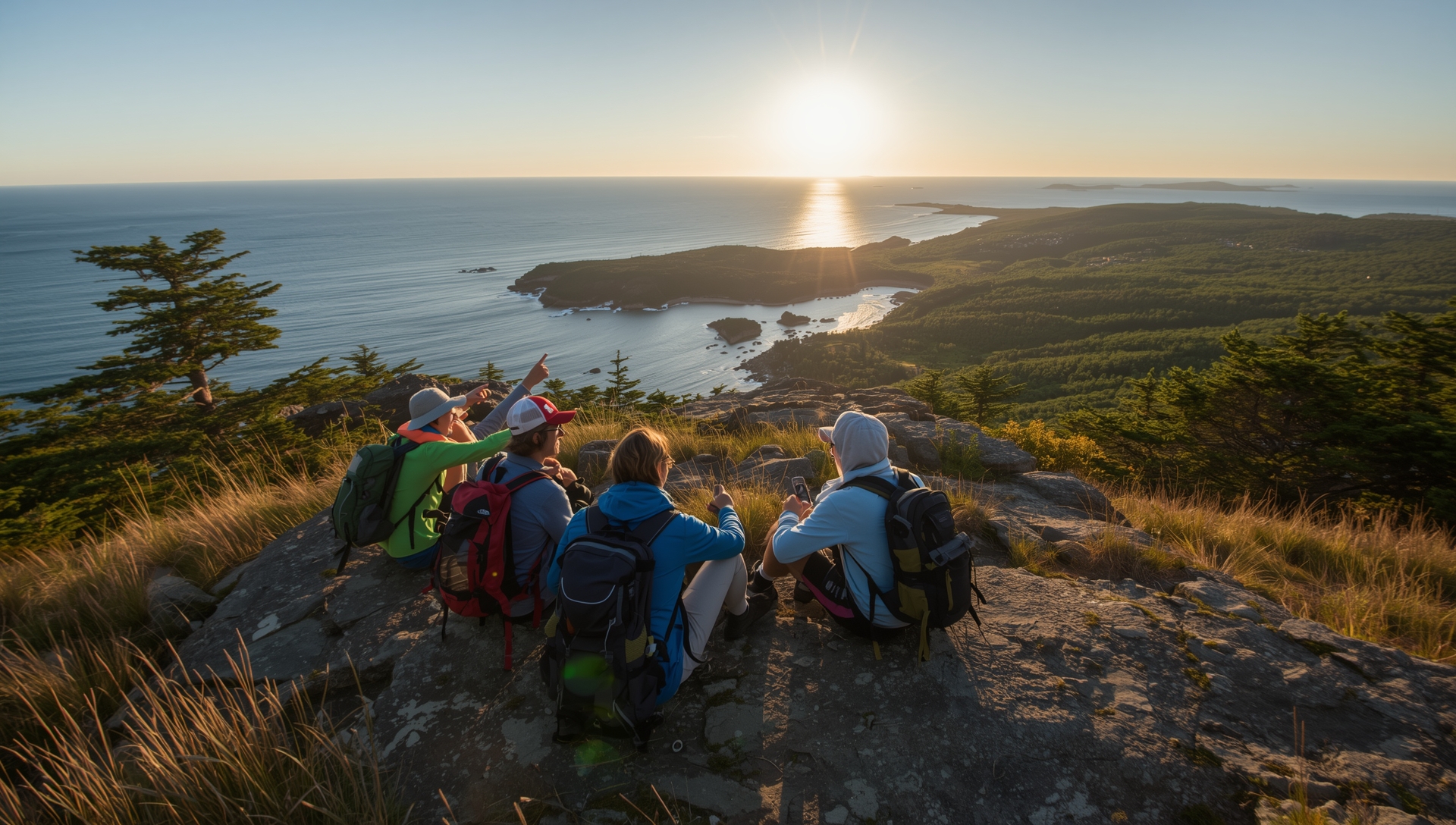Island Explorer Shuttle Acadia
About the Island Explorer Shuttle Acadia
The Island Explorer Shuttle Acadia is one of the most convenient and rewarding ways to explore Acadia National Park. Forget circling for parking or idling in traffic on Park Loop Road — the Island Explorer Bus Acadia lets you sit back, enjoy the scenery, and reach the park’s most iconic destinations with ease. This free, eco-friendly Acadia shuttle system links together Bar Harbor, Hulls Cove Visitor Center, Jordan Pond, Sand Beach, Thunder Hole, and even the quieter Schoodic Peninsula, giving you more time to enjoy the views and less time behind the wheel.
Launched through a partnership between Friends of Acadia, L.L.Bean, and the National Park Service, the Acadia Island Explorer Bus began service in 1999 with a simple mission — to reduce traffic, lower emissions, and preserve Acadia’s fragile landscape. Since then, the Acadia bus system has removed millions of vehicles from park roads and helped visitors discover a calmer, cleaner, and more connected Acadia experience.
Each Island Explorer Shuttle is modern, comfortable, and equipped with air-conditioning and bike racks. Riders can hop on and off at key stops, combining hiking, sightseeing, and picnicking in a single day. Whether you’re traveling solo or with family, the Acadia Island Explorer Bus System offers flexibility and freedom without the noise or congestion of summer traffic.
For those planning summit access, the Cadillac Mountain Shuttle provides separate routes to reach the park’s most famous sunrise viewpoint, while bus tours of national parks USA style experiences let you see the region through a broader lens. Together, these sustainable travel options reflect how Acadia is leading the way among the busiest national parks in USA — proving that exploration and preservation can go hand in hand.
With the Island Explorer Shuttle Acadia, every ride is part of the adventure — and every stop is an invitation to slow down, step out, and see Acadia the way it’s meant to be seen.
- Service: Free, eco-friendly Island Explorer Bus Acadia linking Mount Desert Island and the Schoodic Peninsula.
- Season: Late May through early October — daily routes and frequent departures during summer.
- Major Stops: Bar Harbor, Hulls Cove Visitor Center, Jordan Pond, Sand Beach, and Thunder Hole.
- Partners: Operated by Friends of Acadia, L.L.Bean, and the National Park Service to preserve the park’s natural beauty.
- Extras: Air-conditioned buses with bike racks and wheelchair accessibility across the Acadia Bus System.
- Bonus: Connects with the Cadillac Mountain Shuttle for summit access — one of the most scenic rides in the busiest national parks in USA.
Routes & Major Stops Across Acadia
The Island Explorer Shuttle Acadia weaves through the park like a living thread, joining Bar Harbor’s bustling streets with pine-scented forests, ocean overlooks, and quiet fishing villages. Its network of routes is designed to open every corner of Acadia to travelers who’d rather leave the car behind and let the scenery unfold through the window. Each line tells its own story — one of granite peaks, sea mist, and the people who choose to explore at a slower, more mindful pace.
Route 1. Bar Harbor ↔ Hulls Cove Visitor Center
This is the park’s welcoming handshake — the first line most visitors ride. It carries you from the shops and cafés of Bar Harbor straight to the Hulls Cove Visitor Center, where your Acadia adventure officially begins. For first-time travelers, it’s an easy way to swap the stress of parking for calm anticipation. Step off to collect maps, talk to rangers, and plan your day’s loop through the park. Route 1 sets the tone for a day defined by freedom, simplicity, and clean Maine air.
Route 4: Jordan Pond ↔ Sand Beach ↔ Thunder Hole
If there’s one line that captures Acadia’s essence, this is it. Route 4 connects three of the park’s most iconic sites — the mirror-still waters of Jordan Pond, the soft curve of Sand Beach, and the thunderous roar of Thunder Hole. Every bend of this road offers a different kind of beauty, from pine forests to ocean cliffs. Hikers hop off here to tackle the Beehive Trail, Gorham Mountain, or Ocean Path, knowing they can simply catch the next shuttle back. It’s the most flexible and photo-worthy circuit of all.
Route 7: Northeast Harbor ↔ Southwest Harbor ↔ Seawall
This is Acadia’s quieter side — a scenic line looping through the island’s working harbors and peaceful coves. Northeast Harbor and Southwest Harbor feel worlds away from Bar Harbor’s buzz, offering art galleries, cafés, and calm waterfront walks. The route continues toward Seawall, where the smell of salt and seaweed fills the air. Trails like Wonderland and Ship Harbor start here, inviting visitors to explore the coastal edge at their own pace. Route 7 is for those who like their adventures slow, local, and soulful.
Schoodic Peninsula Route: Winter Harbor ↔ Schoodic Point
Beyond Mount Desert Island lies the wild beauty of the Schoodic Peninsula. This route begins with a ferry ride across Frenchman Bay to Winter Harbor, where the shuttle picks up again and winds through spruce forests and rocky shoreline. The road ends at Schoodic Point, where waves explode against the granite ledges and seabirds trace the horizon. It’s quieter, farther, and every bit as dramatic — a favorite for travelers seeking solitude and the raw power of the Atlantic.Connecting the Routes: Build Your Own Loop
Connecting the Routes: Build Your Own Loop
The real strength of the Acadia Island Explorer Bus network lies in its connections. Transfer points make it easy to link routes, so you can start by the sea, switch inland at Jordan Pond, and end your day at a harbor-side café. With frequent service through summer and early autumn, the Island Explorer Bus Acadia gives you the freedom to shape your own itinerary without worrying about parking or traffic. It’s not just transit — it’s an experience that lets you slow down, look out the window, and feel part of the park itself.
🚐 Island Explorer Highlights
- The Island Explorer Shuttle Acadia links Bar Harbor, Hulls Cove, and Jordan Pond with zero parking stress.
- Acadia Island Explorer Bus routes reach Sand Beach, Thunder Hole, and Seawall — all free to ride.
- Hop aboard the Island Explorer Bus Acadia to explore mountain trails, coastal lookouts, and quiet harbors.
- Each line runs every 30–45 minutes during peak season — perfect for creating custom car-free adventures.
- Connections to the Cadillac Mountain Shuttle make reaching sunrise or summit views simple and sustainable.
From village loops to the Schoodic Peninsula Route, the Island Explorer Shuttle Acadia keeps the park connected — an eco-friendly alternative to driving that turns every ride into part of the experience.
Acadia Island Explorer Map & Shuttle Routes
The Acadia Island Explorer Map is the traveler’s key to understanding how the Island Explorer Shuttle Acadia threads through Mount Desert Island and the surrounding coastline. Each colored line on the map represents a route that brings together Bar Harbor’s lively waterfront, Jordan Pond’s mirror-still water, the thunderous cliffs of Sand Beach and Thunder Hole, and the quieter charm of the Southwest Harbor and Schoodic Peninsula loops. More than a diagram, it’s a portrait of movement—how the park’s visitors, cyclists, and families connect with nature without relying on their cars.

Every Acadia Island Explorer Bus follows a rhythm carefully designed around visitor flow and scenic access. From the Hulls Cove Visitor Center, the Island Explorer Bus Acadia network spreads outward like branches: one line tracing the Park Loop Road toward Sand Beach and the Beehive, another winding south toward Seawall and Bass Harbor Head Light. Short connector routes link campgrounds, carriage-road entrances, and hotels in Bar Harbor, creating an easy, eco-friendly alternative to driving. Riders can hop on and off at their own pace—exploring one trail, grabbing lunch, and catching the next bus without ever losing the view.
The Acadia Island Explorer Map also highlights key transfer points for visitors who want to build their own scenic circuit. At Jordan Pond, travelers can switch from the inland route to the coastal line that hugs Ocean Path, then transfer again at Bar Harbor to reach the Schoodic Peninsula. The layout is intentionally simple: numbered routes, soft color distinctions, and landmarks noted by name rather than coordinates. It mirrors the real-world experience—friendly, approachable, and built for discovery.
Unlike a typical transit chart, this Island Explorer Shuttle Acadia map reflects a partnership between preservation and practicality. The shuttle system was introduced to reduce congestion and protect the fragile ecosystems along Acadia’s roadsides. Every season, these buses remove thousands of private vehicles from the park’s busiest roads. The map stands as a visual reminder of that effort, showing how sustainable travel can still feel spontaneous and free.
For planners and dreamers alike, the Acadia Island Explorer Map is both a navigation aid and an inspiration. It helps you picture a day that begins with sunrise over Sand Beach, includes a stop at Jordan Pond House for lunch, and ends with sunset from Seawall. With just one glance, you can see how all of Acadia connects—through trails, tide, and time—on a single, easy-to-follow map.
🗺️ Download the Acadia Island Explorer Map
- Plan every Island Explorer Shuttle Acadia route with this full-color Acadia Island Explorer Map.
- See key Island Explorer Bus Acadia lines linking Bar Harbor, Jordan Pond, Sand Beach, Thunder Hole, and the Schoodic Peninsula.
- Includes transfer points, scenic loops, and Cadillac Mountain Shuttle access routes.
- Ideal for offline use while exploring Acadia National Park — keep it on your phone or tablet.
File size: 1.2 MB — viewable on all devices.
How to Use the Shuttle
The Island Explorer Shuttle Acadia runs like a quiet pulse through the park, carrying visitors between mountains, beaches, and harbors with the reliability of a tide. Using it is refreshingly simple—no reservations, no stress, no search for a parking space at sunrise. Whether you’re based in Bar Harbor, staying near Southwest Harbor, or beginning your day at Hulls Cove, this system is designed to make exploring Acadia National Park feel effortless.
Buses run seasonally from late June through mid-October, connecting major destinations such as Jordan Pond, Sand Beach, Thunder Hole, and Schoodic Point. Most routes begin around 7 a.m. and finish by early evening, with departures every 30 minutes to an hour depending on the line. You don’t need to book a seat; just arrive at one of the clearly marked stops and climb aboard. Each bus displays its route number and destination, and friendly drivers are always happy to answer questions about transfer points or connecting routes.
The best approach is to think of the shuttle network as a set of loops. Start by choosing your main route—perhaps Route 4 to visit Jordan Pond and Sand Beach—then use transfer points to branch out. For instance, you might hop from Jordan Pond to the Northeast Harbor loop or head toward the Seawall via Route 7. Schedules are printed at every stop, and route maps are available online and in visitor centers, making it easy to plan a flexible day without ever touching your car keys.
If you’re carrying a bike, most buses include front-mounted racks that can hold two bicycles. They’re easy to load and unload—just signal the driver when you’re ready to disembark. Cyclists often combine routes, riding part of the carriage roads and catching the shuttle back from a different stop. The same convenience applies to hikers: you can start your walk on the Ocean Path near Thunder Hole and catch a return bus from Sand Beach or Jordan Pond later in the day.
For families, the Island Explorer Bus Acadia is equipped with accessible seating, wheelchair lifts, and air conditioning, and welcomes small strollers and daypacks. Service animals are always allowed, though pets must be in carriers. Cell reception fades across Mount Desert Island, so it’s best to download the schedule in advance or take a photo of it at the visitor center. A little preparation means more freedom once you’re deep in the park.
The rhythm of the Island Explorer Shuttle reflects the pace of Acadia itself: calm, steady, and connected to the landscape. It’s a system that rewards spontaneity—you can decide at any stop whether to keep exploring, change direction, or settle down for a lakeside picnic. Leave the driving to someone else and enjoy watching Acadia unfold from your window seat as granite peaks, spruce forests, and shimmering coves roll by.
🥾 Hiker Hint — Getting Around Acadia Made Easy
- Download the full Island Explorer Shuttle Acadia schedule before your trip—cell service can fade on Mount Desert Island.
- No reservations needed, except for the Cadillac Mountain Shuttle.
- Combine the Island Explorer Bus Acadia routes for custom day loops between Bar Harbor, Jordan Pond, and Schoodic Peninsula.
- Bring your bike—most shuttles include racks for easy access to Acadia’s carriage roads.
- Plan eco-friendly adventures while reducing traffic and parking congestion in Acadia National Park.
Cadillac Mountain Shuttle Access
Few places in Acadia National Park are as iconic—or as sought after—as the summit of Cadillac Mountain. Rising 1,530 feet above the Atlantic, it’s the first place in the United States to see the sunrise for much of the year. To protect this fragile mountaintop while maintaining visitor access, the Cadillac Mountain Shuttle offers a simple, sustainable way to reach the summit without the stress of parking or steep driving.
Unlike the Island Explorer Shuttle Acadia, which is free and runs throughout the park, the Cadillac service operates as a reservation-only system through Recreation.gov. This helps limit traffic and protect the delicate alpine environment at the summit. Tickets are affordable and can be booked online before your visit. Once you’ve secured your reservation, you can board from designated stops in Bar Harbor or at the Hulls Cove Visitor Center, connecting easily from the Acadia Island Explorer Bus network.
The shuttle follows the winding Cadillac Summit Road, a 3.5-mile drive that offers breathtaking views of Frenchman Bay, Bar Harbor, and the surrounding islands. As the bus climbs, passengers often fall quiet—part awe, part anticipation—as the landscape opens into wide, sweeping views. For those hoping to catch sunrise, early-morning departures run seasonally and are among the park’s most memorable experiences. Watching the first light spill across the ocean from the top of Cadillac is a moment that lingers long after your visit.
It’s important to note that the Island Explorer Shuttle Acadia does not go to the summit. Instead, you’ll use transfer points to connect with the Cadillac Mountain Summit Shuttle. Schedules align closely, allowing travelers to move smoothly between routes. If you’re connecting from Bar Harbor, Hulls Cove, or Jordan Pond, expect the full journey to the top to take around 45–60 minutes, including transfer time.
Once at the summit, visitors can explore short walking paths around the granite crown of the mountain, photograph the 360-degree panorama, or visit the small summit gift shop and ranger station. The Cadillac Mountain Sunrise Shuttle operates on a slightly earlier schedule, allowing travelers to reach the summit well before dawn. It’s advisable to arrive early and bring a flashlight, warm clothing, and your confirmation ticket—conditions can change quickly at high elevation.
Using the Cadillac Mountain Shuttle not only simplifies your visit but also supports the park’s long-term sustainability goals. With limited parking and a fragile alpine ecosystem, every visitor who chooses the shuttle helps reduce traffic, erosion, and emissions on one of Acadia’s most beloved peaks. Whether you’re heading up for sunrise, mid-morning views, or a sunset return, this service lets you experience the summit the way it was meant to be—peacefully, thoughtfully, and without the hassle of finding a spot to park.
🌄 Summit Shuttle Note — Your Link to the Top
- The Island Explorer Shuttle Acadia does not go directly to the summit of Cadillac Mountain.
- To reach the top, use transfer points to connect with the Cadillac Mountain Shuttle service.
- Book tickets in advance for the Cadillac Mountain Summit Shuttle or Cadillac Mountain Sunrise Shuttle through the official park reservation system.
- Allow about an hour from Bar Harbor or Hulls Cove, including transfer time.
- Bring warm layers—temperatures at the summit can be 10–15°F cooler than at sea level.
Accessibility & Family-Friendly Features
The Island Explorer Shuttle Acadia National Park makes exploring easy, inclusive, and sustainable — whether you’re traveling solo, with friends, or as a family. Every route is built around accessibility, ensuring that all visitors can enjoy the best of Acadia National Park without the stress of parking, long drives, or navigating narrow roads.
Each Island Explorer bus is wheelchair-accessible, featuring low-floor entry, automatic ramps, and priority seating near the front. Drivers are trained to assist passengers with mobility devices, strollers, and bags, so boarding and disembarking are always smooth. The interiors are designed with safety in mind — wide aisles, grab rails, and clearly marked standing areas make it easy for everyone to travel comfortably.
Families especially appreciate how practical the Acadia Island Explorer Bus is for sightseeing. Strollers don’t need to be folded, and children can watch for wildlife through the wide panoramic windows. The Jordan Pond, Sand Beach, and Northeast Harbor routes are popular among families because they combine easy access to picnic areas, restrooms, and short walking trails. These stops make it simple to spend a relaxed day in nature — without juggling car seats or worrying about parking near trailheads.
For older visitors, the Island Explorer Shuttle Acadia offers a calm, air-conditioned alternative to driving through busy sections like Park Loop Road or Cadillac Mountain Road. Seats are well-padded, the ride is quiet thanks to clean-burning propane engines, and the friendly drivers often share local tips or stories. Even on a warm day, the experience feels peaceful, not rushed.
The shuttle network also supports eco-friendly travel in Acadia National Park, running entirely on propane to reduce emissions and noise pollution. Each passenger who chooses the shuttle helps protect Acadia’s fragile ecosystems — from its spruce-fir forests to the rocky coastal headlands. The Island Explorer Shuttle truly represents a partnership between comfort, conservation, and community.
Whether you’re planning a multi-stop hiking adventure, a gentle scenic ride, or a fun day exploring with kids, the shuttle connects every corner of the park — from Bar Harbor to Jordan Pond and across to the Schoodic Peninsula — so every traveler can enjoy Acadia at their own pace.
- All Island Explorer Acadia buses are ADA-compliant and fully accessible.
- Drivers assist with wheelchairs, strollers, and boarding ramps.
- Routes 4, 6, and 7 are ideal for families with children and scenic picnic stops.
- Air-conditioned cabins and clean propane engines ensure a quiet, eco-friendly ride.
- Each ride supports sustainable travel in Acadia National Park.
Planning Your Trip Around the Island Explorer Shuttle Acadia
One of the smartest moves any visitor can make when exploring Acadia National Park is to plan their day around the Island Explorer Shuttle Acadia. This free, eco-friendly bus system connects all major destinations — from the Hull’s Cove Visitor Center to Sand Beach, Jordan Pond, and even the Schoodic Peninsula. Designed to make travel stress-free, it allows you to enjoy the park’s highlights without hunting for parking or worrying about park entry congestion.
If you’re staying in Bar Harbor, several routes stop right near hotels and downtown lodgings, meaning you can leave your car parked for the entire trip. Families often base themselves near the Route 1 or 4 lines, making it easy to head to Thunder Hole, Cadillac Mountain, or Jordan Pond House for lunch before looping back through Northeast Harbor or Seal Harbor. The shuttle is built for flexibility — you can hop off at scenic stops, take a short hike, and catch another bus later to continue your adventure.
To make the most of your day, check the seasonal schedule online or at any visitor stop. Most routes run every 20–30 minutes during peak season (late June through mid-October), with clearly marked connection points for transfers. Be sure to grab a printed Island Explorer map or download the real-time tracker app for live bus updates — a major convenience when timing hikes or photography sessions around sunrise or sunset.
For early risers, the Cadillac Mountain Summit Shuttle can be coordinated with morning departures from Bar Harbor. Sunset seekers, meanwhile, can ride to Seawall or Otter Point for incredible evening views. The park encourages visitors to think of the shuttle as a loop system that opens up flexible exploration — not a fixed schedule you’re locked into.
A smart approach is to plan one “loop” each day: perhaps Route 3 for the eastern park highlights on your first day, Route 7 for the western villages on the second, and Route 8 to explore Schoodic Point if time allows. This way, you’ll experience the full range of Acadia’s coastlines, forests, and local charm — all without the stress of driving or parking.
🗺️ Shuttle Smart — Plan Ahead for the Island Explorer
- Review the Island Explorer Shuttle Acadia timetable before setting out — frequency varies by route.
- Stay near stops along Routes 1, 4, or 7 if you plan to explore Bar Harbor, Jordan Pond, or Southwest Harbor.
- Download the real-time tracker to monitor buses heading toward Cadillac Mountain or Sand Beach.
- Bring layers — the weather can shift quickly, especially near Cadillac Mountain Summit.
- Remember that Island Explorer bus Acadia routes change slightly after mid-October — check dates before you go.
Sustainability & the Shuttle’s Mission
The Island Explorer Shuttle Acadia is far more than a practical transport system — it’s one of the most successful sustainability initiatives in any U.S. national park. From the moment it launched in 1999, this clean, propane-powered fleet has represented the spirit of cooperation between the National Park Service, Friends of Acadia, L.L. Bean, and local communities. Their shared vision was simple but profound: preserve the tranquility of Acadia National Park by reducing vehicle congestion, cutting emissions, and giving visitors a stress-free, environmentally friendly way to explore Mount Desert Island. Over the years, that vision has transformed into a living example of conservation in motion — and today, the Acadia Island Explorer Bus is at the center of it all.
Every year, millions of visitors arrive at Acadia, and without the Island Explorer Shuttle, the narrow roads leading to landmarks like Cadillac Mountain, Jordan Pond, and Sand Beach would grind to a halt. Instead, the shuttle keeps traffic manageable, allowing the park’s roads to remain peaceful and its air refreshingly clean. Each bus runs on propane or compressed natural gas (CNG), both of which dramatically lower carbon emissions compared to gasoline. These eco-friendly vehicles have collectively replaced millions of private car trips, preventing an estimated 30 tons of CO₂ from entering the atmosphere each year. Now, with hybrid and electric buses joining the fleet, the system continues to evolve toward the park’s long-term goal of carbon neutrality.
But sustainability isn’t limited to the fleet itself — it’s woven into the infrastructure that supports it. The Hulls Cove Visitor Center, which acts as a major hub for the Island Explorer Shuttle Acadia, features solar power installations, recycling facilities, and bike racks that encourage multi-modal travel. Even the shuttle stops are built with minimal environmental impact in mind, using natural materials that blend into the surrounding forest. These small design choices reflect the same philosophy that inspired the service to begin with: humans and nature should move in harmony, not competition.
By riding the Island Explorer Shuttle, visitors become active participants in the protection of Acadia’s landscapes. Each empty car space at Jordan Pond, each quiet moment atop Cadillac Mountain without the sound of engines idling, is a reminder that collective action makes a difference. It’s not just about reaching your next viewpoint — it’s about traveling lightly and responsibly. Rangers often describe it best: “Every time someone chooses the shuttle over their car, they’re helping Acadia breathe a little easier.”
The shuttle’s success is powered by partnership. Friends of Acadia continues to reinvest in cleaner technology and better visitor information, while L.L. Bean and community sponsors keep the service free for everyone. As a result, the Island Explorer has become an enduring model for sustainable tourism — proof that accessibility and conservation can share the same road.
🌱 Green Miles: Every Ride Makes a Difference
- 30 tons of CO₂ saved each year by the Island Explorer Shuttle Acadia.
- Propane and CNG buses replace thousands of car trips daily.
- New hybrid and electric shuttles are joining the fleet in 2025.
- Solar-powered stops and bike-friendly access encourage low-impact travel.
- Each ride supports Friends of Acadia’s Clean Transportation Initiative.
Traveler Experiences & Local Support
The Island Explorer Shuttle Acadia has become more than a transportation network—it’s a shared experience that connects travelers, locals, and the landscape in a way that feels authentically Acadian. Whether you’re boarding the Acadia Island Explorer Bus from Bar Harbor’s village green, transferring at Jordan Pond, or coasting along the Schoodic Peninsula route, there’s a quiet rhythm to the journey that makes it special. Riders often describe the shuttle as part of the park’s character—unhurried, welcoming, and full of stories told between stops.
Families love the ease of hopping on board after breakfast at a harbor café, skipping the parking chaos, and arriving directly at Sand Beach, Thunder Hole, or Jordan Pond House without ever starting their car. Parents note how the ride itself becomes part of the adventure—children pointing out lighthouses or deer along the road, grandparents recalling the park from decades ago, and first-time visitors watching the forest shift into open ocean views. For hikers, it’s freedom in motion: the ability to begin on one trail, transfer lines, and finish the day miles away without retracing a single step.
Local residents share in the shuttle’s impact, too. Seasonal employees, park rangers, and shop owners in Bar Harbor, Southwest Harbor, and Winter Harbor rely on the Island Explorer Bus Acadia as an eco-friendly commute and as a symbol of pride. The service provides jobs, supports local tourism, and reduces the traffic strain on small village roads. For businesses, the difference is measurable—fewer congestion complaints, more satisfied visitors, and a healthier environment that keeps Acadia’s reputation shining among the busiest national parks in the USA.
Stories from travelers often echo a shared sentiment: that the shuttle represents the best kind of travel—simple, sustainable, and communal. You’ll meet photographers carrying tripods for the Cadillac Mountain Sunrise Shuttle, hikers bound for the Beehive Trail, and artists sketching near Thunder Hole. Each passenger adds a small piece to the living mosaic of Acadia. Even the short waits at Hulls Cove or the laughter during rainy-day rides feel like part of the park’s rhythm—proof that exploration doesn’t have to mean isolation.
At the heart of this community connection are the volunteers and donors who keep the Island Explorer Shuttle Acadia running strong. Organizations like Friends of Acadia and partners such as L.L.Bean fund improvements, while local drivers and rangers offer insights and guidance with genuine Maine hospitality. Their collaboration ensures that each ride isn’t just a trip—it’s a contribution to a sustainable future and a warm introduction to the people who call Mount Desert Island home.
Every rider, whether a visitor or resident, becomes part of a shared journey that extends beyond the bus route. The Island Explorer isn’t just the easiest way to get around Acadia National Park—it’s one of the most meaningful, blending conservation, connection, and community into a single scenic ride.
🚌 Community Connections: More Than Just a Ride
- Over 3 million riders have used the Island Explorer Shuttle Acadia since 1999.
- The service supports local jobs and reduces downtown traffic by thousands of cars each summer.
- Friendly drivers share tips on hikes, viewpoints, and picnic spots along every route.
- Local partnerships with Friends of Acadia and L.L.Bean help keep rides free for everyone.
- Many visitors say their favorite park memory started right on the shuttle.
Island Explorer Shuttle FAQs
Exploring Acadia National Park, one of the busiest national parks in the USA, becomes far simpler thanks to the Island Explorer Shuttle Acadia—a free, eco-friendly transport network that connects nearly every scenic highlight on Mount Desert Island. Here’s a complete guide to help you understand how it works, whether you’re planning to hike Cadillac Mountain, visit Jordan Pond, or tour the Schoodic Peninsula car-free.
- What is the Island Explorer Shuttle Acadia?
The Acadia Island Explorer Bus is a propane-powered public transit system operating across Bar Harbor, Hulls Cove Visitor Center, and key park destinations. It was developed through a collaboration between Friends of Acadia, L.L. Bean, and the National Park Service to reduce congestion and carbon emissions. This initiative is not just transportation—it’s part of Acadia’s ongoing conservation mission to keep one of America’s most visited parks accessible and sustainable.
- When does the Island Explorer Bus Acadia operate?
The Island Explorer Shuttle Acadia typically runs from late June through early October, covering peak summer and fall foliage seasons. Buses circulate between popular stops like Sand Beach, Thunder Hole, Jordan Pond, and Northeast Harbor every 30 minutes during the day, with extended evening service to Bar Harbor and the Hulls Cove Visitor Center. Timetables are easy to access on printed brochures or via the Acadia Island Explorer Map online and at all visitor centers.
- Is the Acadia Island Explorer really free?
Yes—there’s no charge for any route. The Island Explorer Bus Acadia is funded through grants and local partnerships, ensuring that every visitor can travel freely within Acadia. This makes it a unique and budget-friendly option among bus tours in national parks USA-wide, where fees often apply.
- How do I reach Cadillac Mountain using the shuttle?
While the Island Explorer Shuttle does not go directly to the summit, travelers can connect via the Cadillac Mountain Shuttle, Cadillac Mountain Summit Shuttle, or Cadillac Mountain Sunrise Shuttle, depending on their timing and ticket preference. These specialized routes link from transfer points near Bar Harbor or Hulls Cove and require advance reservations through Recreation.gov. It’s one of the best ways to witness sunrise from the first place in the U.S. touched by morning light.
- Are the Island Explorer buses accessible?
Yes. Every Island Explorer Acadia vehicle features wheelchair lifts, ramps, and priority seating, ensuring comfortable use for all passengers. The program’s focus on inclusivity extends to stroller storage and assistance for riders with limited mobility. Drivers are trained to help families, seniors, and visitors with disabilities embark safely.
- Can I bring bikes or hiking gear?
Absolutely. Each Acadia Island Explorer Bus is fitted with bike racks, allowing riders to combine a scenic cycling route with a relaxing shuttle return. Hiking packs, tripods, and small coolers are fine—but leave large gear or camping frames at your lodge to keep aisles clear. This car-free setup is perfect for eco-travelers exploring busiest national parks in USA responsibly.
- Where can I get more details?
Stop by the Hulls Cove Visitor Center for maps, updates, and ranger assistance—or download the Acadia Island Explorer Map before your trip. The shuttle system is not just a convenience; it’s a sustainable travel model celebrated across all bus tours national parks USA networks.
🚌 Shuttle Know-How – Plan Smart, Ride Free
- The Island Explorer Shuttle Acadia connects Bar Harbor, Hulls Cove, Jordan Pond, and Schoodic Peninsula with free, propane-powered buses.
- Use the Acadia Island Explorer Map or printed route guides available at the Hulls Cove Visitor Center to plan your trip efficiently.
- Reach Cadillac Mountain via the Cadillac Mountain Shuttle, Cadillac Mountain Summit Shuttle, or Cadillac Mountain Sunrise Shuttle—advance reservations required.
- All Island Explorer buses Acadia are accessible, with lifts, ramps, and priority seating for wheelchairs, strollers, and passengers needing assistance.
- Combine rides with hiking or cycling adventures using the bus racks—ideal for sustainable travel across one of the busiest national parks in USA.
- Perfect for families, couples, or solo travelers exploring Acadia without a car—completely free, convenient, and environmentally friendly.
Reflect & Explore More
The Island Explorer Shuttle Acadia isn’t just a way to get from one trail to another — it’s part of the park’s story. Every route, every rider, and every shared smile between strangers plays a role in preserving Acadia’s peace. From the Cadillac Mountain Shuttle winding to the summit at sunrise, to the quiet Schoodic Peninsula route tracing Maine’s rugged coast, each ride helps protect the park’s fragile beauty by reducing congestion, noise, and emissions.
For travelers, it’s a reminder that adventure doesn’t need to leave a heavy footprint. Families can discover the joy of watching wildlife through the window instead of a windshield. Hikers can stretch their legs on the way to the next trailhead. And visitors can experience the community spirit that defines Mount Desert Island — from Bar Harbor’s cafés to Hulls Cove Visitor Center, where every journey begins with a friendly wave.
If you’re planning your first trip or your fifteenth, let the Acadia Island Explorer Bus lead the way. It’s comfortable, free, and built on the values that make Acadia so loved — connection, conservation, and care.
As the bus hums along the Park Loop Road, think of it as part of the rhythm of the park — carrying stories, laughter, and the promise of another day spent between the ocean and the pines.
🌿 Riding Toward a Greener Acadia
- Free, eco-friendly travel across **Acadia National Park** and nearby towns.
- Connects **Cadillac Mountain**, **Schoodic Peninsula**, and **Bar Harbor** routes.
- Supports cleaner air, fewer cars, and a quieter visitor experience.
- Operated by Friends of Acadia, L.L. Bean, and the National Park Service.
- Perfect for hikers, families, and anyone seeking a sustainable way to explore.
🌲 Ready to Explore More of Acadia?
The Island Explorer Shuttle is just one of the many ways to experience the magic of Acadia National Park. From mountain summits to rugged shores, every turn brings a new adventure. Start planning your next stop and uncover the best hikes, viewpoints, and hidden gems across Mount Desert Island.
Explore Acadia National Park🔗 Helpful Resources for Planning Your Ride
- Official Island Explorer Shuttle — schedules, route maps, and accessibility details available at ExploreAcadia.com.
- National Park Service: Acadia — visitor updates, park alerts, and transport info at NPS.gov/Acadia.
- Downeast Transportation — regional connections between Bar Harbor, Ellsworth, and Mount Desert Island at DowneastTrans.org.
All links open in a new tab for your convenience.
📨 Stay Connected with The Park Trail
Love discovering hidden corners of Acadia? Join Ranger’s Notes — our free monthly newsletter filled with national park stories, travel tips, and updates from The Park Trail community.
Sign Up